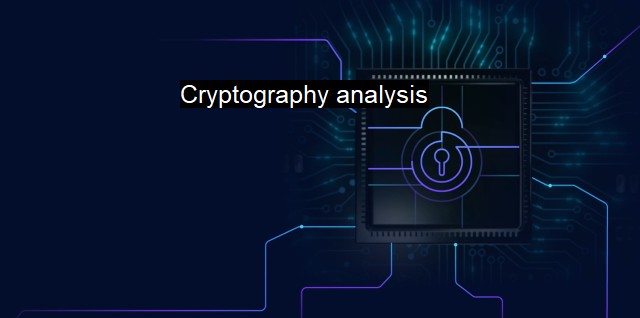What are Cryptography analysis?
Cryptography Analysis: Strengthening Cybersecurity and the Bedrock of Secure Information Exchange Worldwide
Cryptography analysis refers to the study and evaluation of cryptographic systems to understand how well they can stand up to attacks and potential vulnerabilities. This term is used in relation to cybersecurity, antivirus software, and digital communication systems to ensure the confidentiality, integrity, and availability of data. Cryptographic systems perform a vital role in the protection of information and data, which is the primary goal of cybersecurity.As technology advances, so too does the sophistication and complexity of attacks on digital infrastructure. Breaches of security can have severe consequences, ranging from financial loss up to threats to national security. Hence, understanding and examining the strength and weaknesses of cryptographic systems becomes an absolute necessity for thwarting such attacks. Cryptography analysis aims to identify potential weak spots, contradictions, and inconsistencies in an algorithm to increase the strength and the efficiency of the encryption and protect the stored or transmitted data.
Cryptography employs a variety of algorithms to encrypt data through complex mathematical processes. Data transformed this way is referred to as ciphertext. The information is deciphered through the use of unique encryption keys, restoring the original data or plaintext. To effectively conduct an analysis of a cryptographic system, it is necessary to understand its operational mechanisms, vulnerability points, key management processes, and algorithm structure.
Steps in cryptography analysis usually involve comprehending the operation and design of cryptographic algorithms, mathematical proof of relevant algorithmic correctness, and simulating threat scenarios to understand possible outcomes. A detailed study of the entire cryptosystem – its inputs, outputs, and intermediary processes – forms a significant part of the analysis.
Assessing the vulnerabilities in cryptographic systems helps to verify their strength against deciphering attacks, protocol attacks, side-channel attacks, among others. A deciphering attack refers to trying to decode the encrypted message without the decryption key. Protocol attacks aim at exploiting the errors in algorithm design and logic, whereas side-channel attacks seek to exploit vulnerable aspects of cryptography that are unrelated to the algorithm, such as power consumption, execution time, and sound waves. The prime objective of cryptography analysis is to defend these attacks efficiently and keep the system impenetrable.
Cryptography analysis plays a part in antivirus software protection too. Sophisticated malware and viruses are known to use encrypted data to initiate intrusive attacks unnoticed. By applying cryptographic measures, these threats can get detected in their encrypted state, safeguarding the system from a potential virus attack. Cryptographic hashes are commonly employed in antivirus programs to update virus databases and to identify malicious code. Thus, auditing and analyzing these cryptographic sequences are essential for protecting against sudden outbreaks of new virus strains.
In the dynamic and ever-evolving cyberspace, cryptography analysis plays a key role in maintaining ahead of new dangers and threats. With cyber-threat incidents escalating globally - in terms of sophistication and damaging potential – it's crucial that organizations continue to invest a substantial amount of resources into cryptography analysis. Beyond mere data protection, maintaining the robustness of encryption algorithms, and thus of antivirus software, carries extreme importance in terms of maintaining consumer trust and conformance to legal regulations.
Cryptography analysis forms the bedrock of effective cybersecurity strategies and programs. It’s not merely about strengthening cybersecurity defenses or developing robust antivirus software, but it's about creating a secure ecosystem where data and information can flow with an assurance of high confidentiality, integrity, and availability. It is an evolving discipline that requires the skilled understanding of mathematical principles, computer science fundamentals, and real-world cybersecurity threats. As the world moves ahead on the path of digital transformation, cryptography analysis will necessarily be at the front line of security, integrity, and data protection.

Cryptography analysis FAQs
What is Cryptography analysis?
Cryptography analysis is the process of examining and deciphering encrypted data to understand its meaning. It involves understanding the encryption algorithms, identifying the encryption keys and breaking the encryption to gain access to the data.Why is Cryptography analysis important for cybersecurity?
Cryptography analysis is crucial for cybersecurity because it helps in identifying vulnerabilities in encryption algorithms and detecting attacks on encrypted data. It helps in understanding the strength of a system's encryption and identifying weaknesses that attackers could exploit.What are the tools used for Cryptography analysis?
There are several tools used for Cryptography analysis, including software programs such as Wireshark, Fiddler, Cain and Abel, and John the Ripper. These tools help in analyzing encrypted traffic, identifying encrypted data, and breaking encryption to access the data.Who can perform Cryptography analysis?
Cryptography analysis requires a specialized skill set and is usually performed by cybersecurity professionals or experts in the field of cryptography. They should have a deep understanding of encryption algorithms, cryptographic keys, and how to use Cryptography analysis tools.| | A | | | B | | | C | | | D | | | E | | | F | | | G | | | H | | | I | | | J | | | K | | | L | | | M | |
| | N | | | O | | | P | | | Q | | | R | | | S | | | T | | | U | | | V | | | W | | | X | | | Y | | | Z | |
| | 1 | | | 2 | | | 3 | | | 4 | | | 7 | | | 8 | | |||||||